Art & Activism in the Age of Globalization: Reflect No. 8, edited by Lieven de Cauter, Ruben de Roo and Karel Vanhaesebrouck (available on amazon USA and UK.)
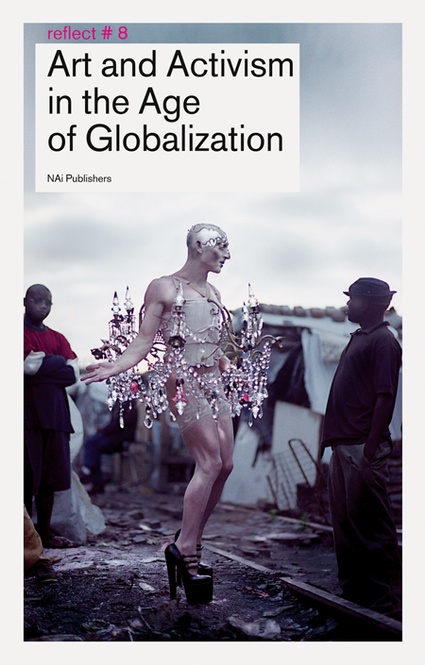 NAI Publishers says: Should artists be activists? Is activist art one of an artist’s primary responsibilities or a pointless sideshow on the fringes of serious politics? The philosopher, writer and art historian Lieven de Cauter, Ruben de Roo and Karel Vanhaesebrouck explore this theme in collaboration with other thinkers and doers in his new book Art and Activism in the Age of Globalization.
NAI Publishers says: Should artists be activists? Is activist art one of an artist’s primary responsibilities or a pointless sideshow on the fringes of serious politics? The philosopher, writer and art historian Lieven de Cauter, Ruben de Roo and Karel Vanhaesebrouck explore this theme in collaboration with other thinkers and doers in his new book Art and Activism in the Age of Globalization.
In a time of globalization, populism, hypercapitalism, migration, War on Terror, and global warming, artistic engagement is vital. Art and Activism in the Age of Globalization takes the measure of contemporary activist art. What is the role of art and activism in the polarized, populist society of the spectacle? Art & Activism examines both the criticism of engagement as a mere pose and the need for cultural activism in today’s society. Urban activism and activism by anonymous networks are also investigated. Special attention is devoted to the effects of the War on Terror on activism in practice. The book concludes with a theoretical framework for contemporary activism and an impassioned plea for genuinely political art.
 Errorist International, Operation BANG!, 2005
Errorist International, Operation BANG!, 2005
It is traditional in the blogosphere (is anyone still using this word?) to close the year with a ‘best of’ post listing the 10 most popular stories, the best exhibitions seen, the gadgets that have changed our life. I wish i could do it, it’s excellent for traffic. Alas! i have the memory of a mongoose and i’m too lazy to go through the archives of the blog. But i can safely declare that the best book i’ve read in 2011 was Art & Activism in the Age of Globalization.
A number of books about art and activism have landed on my doorstep over the past few years but this is the first one that takes as its premise the fact that activism, protest, subversion, disruption, criticism, community, resistance, etc. have become little more than buzzwords. Punk has lost its bite and essence and is now little more than a fashion trend. Che Guevara is more famous for the t-shirts his face sells than for the role he played in the Cuban Revolution. Subversion has been the cornerstone of Madonna’s rise to pop power for decades. The discursive fringe has reached the mainstream. Resistance is hip! Subversion is cool!
The popularity of these terms have depleted them from any meaning or strength. Well almost… Today you can land a commission or assignment from public institutions and private sponsors by writing application that claims that your ‘subversive’ artwork will raise ‘a healthy debate in the community’.
The editors of the book have therefore found it necessary to come up with a new word to define a powerful strategy that connects art and political engagement: subversivity. Subversivity is a disruptive attitude that tries to create openings, possibilities in the ‘closedness’ of a system.
The quality of the book extends way beyond its premise. Art & Activism in the Age of Globalization is composed of 30 essays by artists, art historians, philosophers, cultural critics, social scientists, curators, theatre directors, etc. I expected at least one or two of these texts to be bland, too scholarly, or cliché. But all i read was solid and relevant. There were a few repetitions but i never grew tired of the thoughts, experiments and ideas shared in the book.
The texts jumped from one discipline to another: visual art, theatre, architecture, hacktivism, urbanism, performances. They discussed artistic and activist practice in Europe and North America of course but also in Syria (exploring the form activism can take in a country where public activity is closely monitored by the State), South Africa, Argentina and other countries which ought to appear more often on the contemporary art map.
Unlike many books i review on the blog, this one contains very few images. Two to be precise and that includes the one on the cover. I didn’t really miss the images and discovered a few artistic/activist projects that would have deserved an individual post:
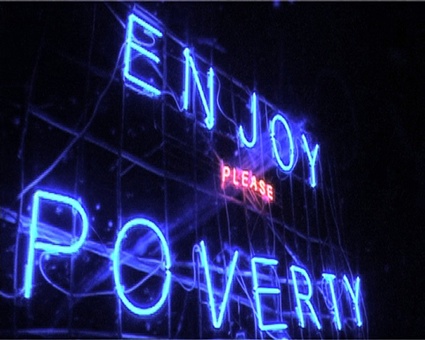 Renzo Martens, still from Episode 3, 2008
Renzo Martens, still from Episode 3, 2008
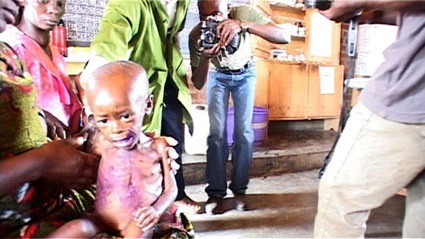 Renzo Martens, still from Episode 3, 2008
Renzo Martens, still from Episode 3, 2008
Ruben De Roo takes Renzo Martens’ film Enjoy Poverty as a platform to explore how artists can stimulate the political consciousness of the consumers of tragedies that we (‘Western’ audiences) are. A few years ago, Martens went to the Democratic Republic of Congo to launch a two-year project that examined the exploitation of one of Africa’s major exports: images of poverty and suffering. The artist traveled with a blue neon billboard that read ENJOY POVERTY and worked with Congolese photographers, teaching them how to sell images of suffering to Western media and aid agencies.
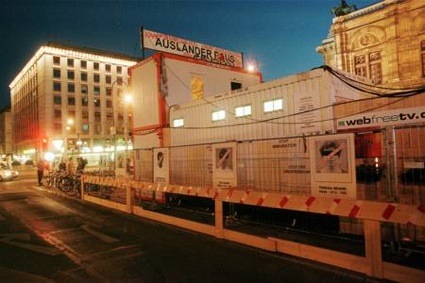 Christoph Schlingensief, Bitte liebt Österreich / Please Love Austria, 2000 (Image: Baltzer)
Christoph Schlingensief, Bitte liebt Österreich / Please Love Austria, 2000 (Image: Baltzer)
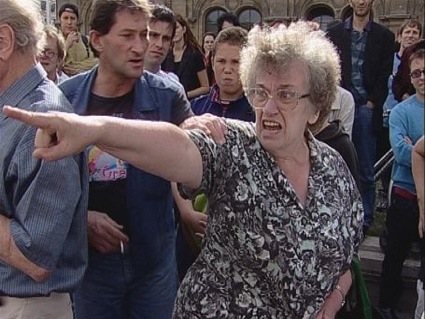 Christoph Schlingensief, Bitte liebt Österreich / Please Love Austria, 2000 (Photo © Paul Poet)
Christoph Schlingensief, Bitte liebt Österreich / Please Love Austria, 2000 (Photo © Paul Poet)
In their remarkably powerful and compelling essay, members of the collective BAVO call for socially committed artists to abandon “NGO art” (mostly art devoid of any political stand for fear of loosing subsidies) and urged them to be ‘really political’ by developing strategies and practices of resistances that stretch the limits of their discipline in the direction of radical politics. They gave Christoph Schlingensief’s Please Love Austria as a meaningful example of art engaging with politics:
In 2000, shortly after Jörg Haider’s far right party became part of the Austrian government, Christoph Schlingensief set up a camp for asylum seekers in a shipping container outside the Vienna Opera House. Twelve asylum seekers lived in the container for 6 days, their lives streamed over the web in a kind of Big Brother show, and the audience were invited to vote their least favourite players to exit the container and be deported to their native country. Decorated with a banner saying Ausländer Raus! (‘Foreigners out!’), the container became a flashpoint in Austria’s national and racial debate. One of the outcome of the work is that, at the end of the show, antifascist action groups stormed the container and freed the immigrants (who were actually actors.)
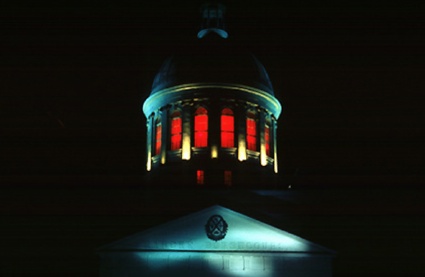 Alfredo Jaar, Lights in the City, in 1999
Alfredo Jaar, Lights in the City, in 1999
Gie Goris mentions Alfredo Jaar‘s Lights in the City as an example of art work that fuels a debate in society and unsettles without resorting to easy provocation.
The artist installed red light on the Copula of the Marche Bonsecours, a landmark monument in the centre of Montreal. The lights were connected to homeless shelters located 500 yards from the building. When a homeless person entered one of the shelters, they could press the button that would make the top of the building glow red.
Eventually all the shelters for homeless people in Montreal could be wired and connected to the Cupola. This way, a major landmark and historical monument in the city would be acting as a non-stop lighthouse, producing endless, painful distress signals to society. With enough media coverage and public outrage and support triggered by these ongoing distress signals, homelessness could be completely eradicated from Montreal, Jaar explained.
The strategy worked so well that the commissioning authority ended the intervention.
The book ends with the most honest plea: to burn the book (or burn your brain) because subversion (or subversivity) can be undermined by essays, books, intellectual jargon and ‘radical’ theories.
Image on the homepage: Steven Cohen, Chandelier, 2001. Photo: John Hogg.
